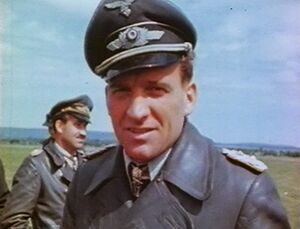Hans-Ulrich Rudel
Hans-Ulrich Rudel (2 July 1916 – 18 December 1982) is described as the most decorated German serviceman of WW2 and the only recipient of the Knight's Cross with Golden Oak Leaves, Swords, and Diamonds. An avowed Nazi, he was a hero of Nazi Germany's Luftwaffe, where he fought primarily as a Junkers Ju-87 'Stuka' pilot; later switching to the Focke-Wulfe FW-190 until the end of the war. He reportedly flew around 2,530 missions over the war from June 1941 until April 1945, exclusively on the Eastern Front. Rudel's personal claim is that he destroyed 2000 targets - 519 tanks, 800+ trucks/vehicles, objects (Ex. bridges), 4 armored trains, 70 landing craft and 2 large naval ships, including the Battleship Marat.
After surrendering to the US forces at the war's end, he immigrated to Argentina as did many other Nazis. There he helped fugitives escape to Latin America and the Middle East, and sheltered Josef Mengele, the infamous SS doctor at Auschwitz. He worked as an arms dealer to several right-wing regimes in South America, for which he was placed under observation by the Central Intelligence Agency. In the West German federal election of 1953, Rudel was the top candidate for the far-right German Reich Party but was not elected. Following the fall of Perón, Rudel moved to Paraguay, where he acted as a foreign representative for several German companies.
Early life
World War II
Post-War Activity
South America
Public Scandals
Personal Life and Death
Summary Military Career
Myths
2000 kills
Rudel is stated to only have flown on the Eastern Front from June (22), 1941 to April, 1945. Roughly 1390 days. An average Stuka mission was 1–2 hours due to the limited range at Sea-level with bomb-load. This means that Rudel flew 2,530 missions for roughly 5000 hours (~200 days), less if the several months of flying the Fw-190 fighter are subtracted. Rudel's personal claim in his autobiographical memoir was that he destroyed 2000 targets - 519 tanks, 800+ trucks and many other objects (bridges and such) including 4 armored trains and 70 landing craft and 2 large naval ships. However this is not confirmed by any source and is ridiculous, especially in regards to tanks. This means that out of 4/5ths of all his missions had him successfully destroy several targets, despite numerous other aces flying many missions and only getting 1/2 or 1/3 of all their missions with multiple destroyed targets or confirmed kills.
The 37mm variant of the Stuka had only 24 rounds for both guns at full load, and required Tungsten ammunition to penetrate T-34s and KV-1s, something that the German army noted back in early 1941, when their 37mm anti-tank cannons barely dented the new Soviet tanks from ANY angle and the 50mm had to be within 100 meters to do so. Moreover, the Stuka was immensely inaccurate. Near Kharkov, the Germans tested aircraft armed with 37-mm cannons. Trophy T-34s and three German pilots on planes with anti-tank guns were placed in the field, attacked them and shot them. The results were simply depressing. Having used up all the ammunition, one hit only three times, the other two, the third generally let everything go by. At the same time, all five hits could not penetrate the tank armor. Now include the fact that real combat T-34s were generally moving and had Air Defense and Fighters running interference, and Rudel's claim that he "destroyed 20 Ivan tanks" in one sortie is very unlikely, let alone 519 over the war. The only remotely believable number in his claim is trucks, because ammunition trucks tended to blow up in chain reactions if they were close together.
A-10 Involvement
A common myth is that Rudel had been an advisor on the Fairchild Republic A-10 Warthog strike aircraft design. Despite his favorability in the US, there is no evidence to this claim. A perusal of Campbell's “The WARTHOG and the Close Air Support Debate” mentions Rudel only in passing; highlighting how his Ju-87G's 37mm guns had required suicidal close-range attacks, overflying enemy defenses, to land any kind of accurate hit. The A-X Proposal, 19 April 1967, Wright-Patterson AFB makes no mention of Rudel, nor in the AFSC Historical Publication: “The A-X Specialized Close Air Support Aircraft: Origins and Concept Phase, 1961-1970” (Edward C. Mishler, Office of History, Headquarters, Air Force Systems Command, United States Air Force, 15 Jun 1977).Rudel is also not mentioned in AFSC Historical Publication: “The A-10 Close Air Support Aircraft: From Development to Production 1970-1976” (George M. Watson, Office of History, Headquarters, Air Force Systems Command, United States Air Force.
